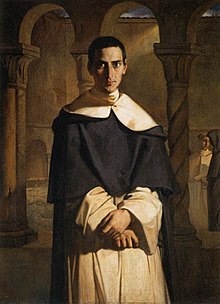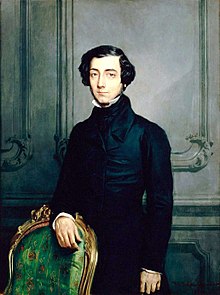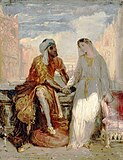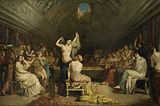| Théodore Chassériau | |
|---|---|
 A self-portrait of Chassériau painted at the age of 16 A self-portrait of Chassériau painted at the age of 16 | |
| Born | (1819-09-20)September 20, 1819 El Limón, Samaná, Santo Domingo |
| Died | October 8, 1856(1856-10-08) (aged 37) Paris, France |
| Nationality | French |
| Education | Jean-Auguste-Dominique Ingres |
| Movement | Romanticism; Orientalism |
Théodore Chassériau (French pronunciation: [teɔdɔʁ ʃaseʁjo]; Spanish: Teodoro Chasseriau; September 20, 1819 – October 8, 1856) was a Dominican-born French Romantic painter noted for his portraits, historical and religious paintings, allegorical murals, and Orientalist images inspired by his travels to Algeria. Early in his career he painted in a Neoclassical style close to that of his teacher Jean-Auguste-Dominique Ingres, but in his later works he was strongly influenced by the Romantic style of Eugène Delacroix. He was a prolific draftsman, and made a suite of prints to illustrate Shakespeare's Othello. The portrait he painted at the age of 15 of Prosper Marilhat makes Chassériau the youngest painter exhibited at the Louvre museum.
Life and work

Chassériau was born in El Limón, Samaná, in the Spanish colony of Santo Domingo (now the Dominican Republic). His father Benoît Chassériau was a French adventurer who had arrived in Santo Domingo in 1802 to take an administrative position in what was until 1808 a French colony. Theodore's mother, Maria Magdalena Couret de la Blagniére, was the daughter of a mulatto landowner born in Saint-Domingue (now Haiti). In December 1820 the family left Santo Domingo for Paris, where the young Chassériau soon showed precocious drawing skill. He was accepted into the studio of Jean-Auguste-Dominique Ingres in 1830, at the age of eleven, and became the favorite pupil of the great classicist, who regarded him as his truest disciple. (An account that may be apocryphal has Ingres declaring "Come, gentlemen, come see, this child will be the Napoleon of painting.")

After Ingres left Paris in 1834 to become director of the French Academy in Rome, Chassériau fell under the influence of Eugène Delacroix, whose brand of painterly colorism was anathema to Ingres. Chassériau first exhibited at the Paris Salon in 1836, and was awarded a third-place medal in the category of history painting. In 1840 Chassériau travelled to Rome and met with Ingres, whose bitterness at the direction his student's work was taking led to a decisive break. While in Italy, Chassériau made landscape sketches and studied Renaissance frescoes.







Among the chief works of his early maturity are Susanna and the Elders and Venus Anadyomene (both 1839), Diana Surprised by Actaeon (1840), Andromeda Chained to the Rock by the Nereids (1840), and The Toilette of Esther (1841), all of which reveal a very personal ideal in depicting the female nude. Chassériau's major religious paintings from these years, Christ on the Mount of Olives (a subject he treated in 1840 and again in 1844) and The Descent from the Cross (1842), received mixed reviews from the critics; among the artist's champions was Théophile Gautier. In 1843, Chassériau painted murals depicting the life of Saint Mary of Egypt in the Church of Saint-Merri in Paris, the first of several commissions he received to decorate public buildings in Paris.
Portraits from this period include the Portrait of the Reverend Father Dominique Lacordaire, of the Order of the Predicant Friars (1840), and The Two Sisters (1843), which depicts Chassériau's sisters Adèle and Aline.
Throughout his life he was a prolific draftsman; his many portrait drawings executed with a finely pointed graphite pencil are close in style to those of Ingres. He also created a body of 29 prints, including a group of eighteen etchings of subjects from Shakespeare's Othello in 1844.
He exhibited the colossal portrait Ali-Ben-Hamet, Caliph of Constantine and Chief of the Haractas, Followed by his Escort in the Salon of 1845, where it received equivocal reviews. In 1846, Chassériau made his first trip to Algeria. From sketches made on this and subsequent trips he painted such subjects as Arab Chiefs Visiting Their Vassals and Jewish Women on a Balcony (both 1849, now in the Louvre). A major late work, The Tepidarium (1853, in the Musée d'Orsay), depicts a large group of women drying themselves after bathing, in an architectural setting inspired by the artist's trip in 1840 to Pompeii. His most monumental work was his decoration of the grand staircase of the Cour des Comptes, commissioned by the state in 1844 and completed in 1848. He followed the example of Delacroix in executing this work in oil on plaster, rather than in fresco. This work was heavily damaged in May 1871 by a fire set during the Commune, and only fragments could be recovered; these are preserved in the Louvre.
After a period of ill health, exacerbated by his exhausting work on commissions for murals to decorate the Churches of Saint-Roch and Saint-Philippe-du-Roule, Chassériau died at the age of 37 in Paris, on October 8, 1856. He is buried in the Montmartre Cemetery.
Technique and style
Chassériau's art has often been characterized as an attempt to reconcile the classicism of Ingres with the romanticism of Delacroix. In composing his narrative paintings, his concern for the decorative arrangement of figures and the creation of a mood took precedence over narrative coherence. His preferred method of working was to study his model carefully and then draw from memory. He favored the serpentine pose, especially for his female figures. Art historian Jonathan P. Ribner calls "the inclined neck and bent knee" Chassériau's "signature motif" and says that "his command of foreshortening and three-dimensional composition remained uneven to the end, and this limitation is reflected in the tenacity of his ... inclination toward flattened, stylized poses." According to Léon Rosenthal, Chassériau was "much less concerned with bringing heroes to life or developing characters than desirous of producing subtle and infinitely rich impressions suggested to him by the themes he chooses".
Legacy
His work had a significant impact on the style of Puvis de Chavannes and Gustave Moreau, and—through those artists' influence—reverberations in the work of Paul Gauguin and Henri Matisse. There is in Paris a Society for the painter: Association des Amis de Théodore Chassériau.
Works of Chassériau are in the Musée du Louvre where a room is dedicated to him, in the Musée d'Orsay, and in the Musée de Versailles. Collections in the United States holding works by Théodore Chassériau include the Metropolitan Museum of Art, New York, the Fogg Art Museum of Harvard University, the National Gallery of Art of Washington, D.C., the Detroit Institute of Arts, the Museum of the Art Rhode Island School of Design, The J. Paul Getty Museum and the Art Institute of Chicago.
Exhibitions
- Théodore Chassériau: Parfum exotique, National Museum of Western Art of Tokyo, Japan, February 28 – May 28, 2017
- Théodore Chassériau: Obras sobre papel, Galerie nationale des beaux-arts de Santo Domingo and Centro cultural León de Santiago de los Caballeros, Dominican Republic, 2004
- Théodore Chassériau (1819–1856): A Different Romanticism, Metropolitan Museum of Art, New York (United States), Galeries nationales du Grand Palais in Paris (France) and Musée des beaux-arts de Strasbourg (France), 2002
- Chassériau (1819–1856): exposition au profit de la Société des amis du Louvre, Galerie Daber, Paris, France, 1976
- Theodore Chassériau (1819–1856), Musée des beaux-arts de Poitiers, France, 1969
- Théodore Chassériau, Musée national des beaux-arts d'Alger, Algeria, 1936
- Retrospective Théodore Chassériau (1819–1856), Musée de l'Orangerie, Paris, France, 1933
- Aquarelles et dessins de Chasseriau (1819–1856), Galerie L. Dru, Paris, France, 1927
- Les Peintres orientalistes français - 4e exposition: Rétrospective Théodore Chassériau, Galerie Durand-Ruel, Paris, France, 1897
Selected works
- Self-portrait - Musée du Louvre
- Aline Chassériau - Musée du Louvre
- Battle of Arab Horsemen Around a Standard (1854) - Dallas Museum of Art
- The Caliph of Constantine, also known as Ali Ben-Hamet, Caliph of Constantine and Chief of the Haractas, Followed by his Escort
- Arab Chiefs Challenging each other to Single Combat under the Ramparts of a City
- Andromeda Chained to the Rock by the Nereids
- Arab Chiefs Visiting their Vassals
- Christ on the Mount of Olives
- The Descent from the Cross
- Diana Surprised by Actaeon
- Jewish Women on a Balcony
- Othello and Desdemona in Venice
- Portrait of the Father Dominique Lacordaire, of the Order of the Predicant Friars
- Susanna and the Elders
- Venus Anadyomene
- The Tepidarium
- The Toilette of Esther
- The Two Sisters
Gallery
-
 Portrait de la comtesse de La Tour Maubourg, 1841, Metropolitan Museum of Art, New York
Portrait de la comtesse de La Tour Maubourg, 1841, Metropolitan Museum of Art, New York
-
 Peace, Protector of the Arts and of the Tilling of the Soil, 1844–1848, oil on plaster transferred to canvas. A surviving fragment of the Cour des Comptes decorations.
Peace, Protector of the Arts and of the Tilling of the Soil, 1844–1848, oil on plaster transferred to canvas. A surviving fragment of the Cour des Comptes decorations.
-
 Othello and Desdemona in Venice, 1850, oil on wood, 25 x 20 cm, Louvre, Paris. Another work inspired by Shakespeare
Othello and Desdemona in Venice, 1850, oil on wood, 25 x 20 cm, Louvre, Paris. Another work inspired by Shakespeare
-
 Scene in the Jewish Quarter of Constantine, 1851, Metropolitan Museum of Art, New York
Scene in the Jewish Quarter of Constantine, 1851, Metropolitan Museum of Art, New York
-
 Orientalist Interior, ca. 1851–1852, oil on wood, 49 x 39 cm
Orientalist Interior, ca. 1851–1852, oil on wood, 49 x 39 cm
-
 Tepidarium, 1853, oil on canvas, Musée d'Orsay
Tepidarium, 1853, oil on canvas, Musée d'Orsay
-
Portrait of Mme Borg de Balsan, 1847, pencil on paper, Philadelphia Museum of Art
-
 Portrait d'Alphonse de Lamartine, 1844, pencil on paper
Portrait d'Alphonse de Lamartine, 1844, pencil on paper
-
 The Child and the Doll, portrait of Laure Stéphanie Pierrugues, 1836, oil on canvas, 79,5 x 57 cm
The Child and the Doll, portrait of Laure Stéphanie Pierrugues, 1836, oil on canvas, 79,5 x 57 cm
See also
Notes
- Jean-Baptiste Nouvion, Chassériau Correspondance oubliée, preface by Marianne de Tolentino, Paris, Les Amis de Théodore Chassériau, 2014
- Guégan et al. 2002, p. 163.
- Guégan et al. 2002, pp. 58, 163.
- Guégan et al. 2002, p. 168.
- Guégan et al. 2002, pp. 60, 168.
- Guégan et al. 2002, p. 170.
- ^ Rosenthal.
- Guégan et al. 2002, p. 53.
- Prat 1989, p. 5.
- Fisher 1979, p. 13.
- Rosenblum 1989, p. 32.
- ^ Ribner, Jonathan P. (1994). "Chassériau’s Juvenilia: Some Early Works by an 'Enfant du Siècle'". Zeitschrift Für Kunstgeschichte, 57(2), 219–238.
- Guégan et al. 2002, p. 287.
References
- Fisher, Jay M. (1979). Théodore Chassériau: Illustrations for Othello. Baltimore: The Baltimore Museum of Art. ISBN 0-912298-50-2.
- Guégan, Stéphane; Pomarède, Vincent; Prat, Louis-Antoine (2002). Théodore Chassériau, 1819-1856: The Unknown Romantic. New Haven and London: Yale University Press. ISBN 1-58839-067-5.
- Miller, Peter Benson (2004). "By the Sword and the Plow: Théodore Chassériau's Cour des Comptes Murals and Algeria," The Art Bulletin vol. 86, no. 4 (Dec. 2004), pp. 690–718.
- Prat, Louis-Antoine. n.d. Theodore Chassériau, 1819-1856: dessins conserves en dehors du Louvre. Paris: Galerie de Bayser . OCLC 800724906.
- Rosenblum, Robert (1989). Paintings in the Musée d'Orsay. New York: Stewart, Tabori & Chang. ISBN 1-55670-099-7.
- Rosenthal, Donald A. "Chassériau, Théodore". Grove Art Online. Oxford Art Online. Oxford University Press. Web.
Further reading
- Bénédite, Léonce (1931). Théodore Chassériau: sa vie et son œuvre, Paris: Les Éditions Braun. OCLC 929584128.
- Bouvenne, Aglaus (1884). Théodore Chassériau: Souvenirs et Indiscrétions, A. Detaille, Paris.
- Bouvenne, Aglaus. Théodore Chassériau : Souvenirs et Indiscrétions (1884), new edition by Les Amis de Théodore Chassériau, 2012 (French language), 2013 (Spanish language).
- Chevillard, Valbert (1893). Un peintre romantique: Théodore Chassériau, Paris.
- Chevillard, Valbert (1898). "Théodore Chassériau" in Revue de l'art ancien et moderne, no. 3, March 10, 1898.
- La Chronique des arts et de la curiosité, no. 9, February 27, 1897.
- Focillon, Henri (1927). "La peinture au XIXe: Le retour à l'antique" in Le Romanticisme, Paris.
- Gautier, Théophile. "L'Atelier de feu Théodore Chassériau" in L'Artiste, no. 14, March 15, 1857.
- Goodrich, Lloyd (1928). "Théodore Chassériau", The Arts 14.
- d'Hérouville, Xavier (2016). L'Idéal moderne selon Charles Baudelaire & Théodore Chassériau, L'Harmattan, Paris.
- Jingaoka, Megumi; Pomarède, Vincent; Nouvion, Jean-Baptiste; Guégan, Stéphane; Okasaka, Sakurako; Nakatsumi, Yuko (2017). Théodore Chassériau : Parfum exotique, , The National Museum of Western Art (Japan).
- Laran, Jean (1913, 1921). Théodore Chassériau, Paris.
- Montesquiou, Robert de (1898). Alice et Aline, une peinture de Théodore Chassériau, Ed. Charpentier et Fasquelle, Paris.
- Nouvion, André-Pierre (2007). Trois familles en Périgord-Limousin dans la tourmente de la Révolution et de L'Empire : Nouvion, Besse-Soutet-Dupuy et Chassériau, Paris.
- Nouvion, Jean-Baptiste; Marianne de Tolentino (2014). Chassériau Correspondance oubliée. Les Amis de Théodore Chassériau edition, Paris.
- Peltre, Christine (2001). Théodore Chassériau. Paris: Gallimard. ISBN 207011564X.
- Prat, Louis-Antoine (1988). Dessins de Théodore Chassériau: 1819–1856. Paris: Ministère de la culture et de la communication, Editions de la Réunion des musées nationaux. ISBN 2711821382.
- Renan, Ary (1897). Les Peintres orientalistes, Galerie Durand-Ruel.
- Sandoz, Marc (1974). Théodore Chassériau 1819–1856: catalogue raisonné des peintures et estampes. Paris : Arts et Métiers Graphiques. ISBN 2700400038.
- Teupser, Werner. Theodore Chasseriau, Zeitschrift für Kunst.
- Vaillat, Léandre (August 1913). "L'Œuvre de Théodore Chassériau", Les Arts.
- Vaillat, Léandre (1907). "Chassériau", L'Art et les Artistes.
External links
![]() Media related to Théodore Chassériau at Wikimedia Commons
Media related to Théodore Chassériau at Wikimedia Commons
![]() Media related to Paintings by Théodore Chassériau at Wikimedia Commons
Media related to Paintings by Théodore Chassériau at Wikimedia Commons
- Website of the 'Amis de Théodore Chassériau' (France)
- Website of the Institut de France (Académie des Beaux-Arts) - Prix de Gravure Chassériau - Last prize was given in 2011 to Dominique Vaillier.
- Famille Chasseriau, Généalogie d'Haiti et de Saint-Domingue
- Théodore Chassériau at Find a Grave
| Théodore Chassériau | |
|---|---|
| Paintings |
|
| Related |
|